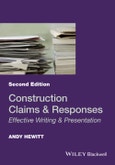A practical, step-by-step guide on how to prepare and respond to construction claims. Everyone involved in the preparation or review of construction claims should have this book to hand. The book examines the different types of claim common to construction contracts and presents a step-by-step guide to demonstrate the process of building up a fully detailed claim submission. It includes advice on:
- Contract administration for claims and claims avoidance.
- Identifying the various types of claim.
- The key points for an effective claim or response document.
- The essential elements to be included in a claim or response.
- Extension of time claims.
- Claims for additional payment.
- Principles of delay analysis.
- Quantum calculations.
- Responses and determinations to achieve agreement and avoid disputes.
- A note on dispute boards.
The advice given in the book is supported by worked examples of typical claims and responses with sample wording.
The book includes a foreword by Roger Knowles, who says:
"The book is without a doubt fully comprehensive and goes though the preparation of a claim from A to Z. I have no hesitation in recommending it to students, beginners, those involved on a day-to-day basis with time and cost on projects, as well as the seasoned claims consultants".
This book is suitable for contracts managers, commercial managers, project managers, quantity surveyors, engineers and architects.
Table of Contents
About the Author ix
Foreword by Roger Knowles xi
Acknowledgements xviii
Chapter 1: Introduction 1
Why is it Necessary to Produce a Fully Detailed and Professionally Presented Claim or Response? 1
The Purpose of the Book 3
Things to be Considered Before Writing the Claim 5
The form of Contract used in the Examples 8
Definitions 9
The example projects 10
Chapter 2: Contract Administration for Claims and Claims Avoidance 11
Introduction 11
The contract documents 11
Programmes and Planning 14
Records, Records, Records 17
Chronology and database 19
Notices 22
Dispute Adjudication Boards and the Like 24
Procedures 25
Chapter 3: Types of Claim 27
Claims for Variations 27
Claims for Extensions of Time 32
Claims for Additional Payment Due to Prolongation 35
Acceleration and Disruption Claims 37
Claims for Damages Under Law 40
Interim and Final Claims 41
Chapter 4: Presentation 43
Presentation of the Submission or Review Document 43
Writing Style 44
Key points for claim presentation 48
Making the Document User‐Friendly 48
Making the submission or review a stand‐alone document 49
Superfluous and irrelevant information 50
Do not Assume that the Reviewer has Prior Knowledge of the Project or Circumstances 50
The importance of leading the reviewer to a logical conclusion 51
Explanations, summaries and conclusions 52
Use of the Narrative to Explain other Documents 52
Substantiation by the use of Exhibits and Additional Documents 53
Compilation of the document 54
Summary of the Principles Covered in this Chapter 56
Chapter 5: Essential Elements of a Successful Claim 57
Introduction 57
Summary of the principles covered in this chapter 81
Chapter 6: The preliminaries to the claim 83
Introduction 83
Chapter 7: The Extension of Time Claim 107
The Method of Delay Analysis 108
The Extension of Time Claim 112
Chapter 8: The Claim for Additional Payment 129
Calculations 142
Chapter 9: The appendices and editing 147
Arrangement of the appendices 147
Editing and review 152
Chapter 10: Claim Responses and Determinations 155
Chapter 11: A note on dispute boards 183
Information Sources 191
FIDIC Clause References 193
Index 195








